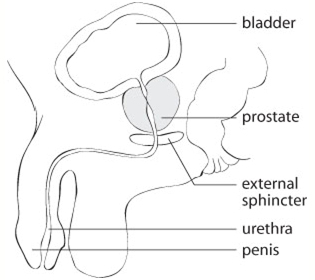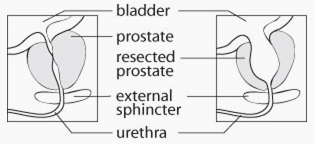
The prostate is a small gland, normally the size of a chestnut, surrounding a man's urethra (“urinary tube”), between the bladder and the control muscle (external sphincter).
With age, the prostate often increases in size and compresses the urethra making it more difficult for the bladder to empty. Voiding (urinating) difficulty can often be determined to be due to obstruction by the prostate (benign prostatic hyperplasia or B.P.H.).
Although there are many ways to treat BPH, many men can be treated safely and effectively by coring out the inner prostate with a special instrument placed through the penis: transurethral resection of the prostate, or TURP. This removes the obstruction, allowing the urine to flow more freely and the bladder to empty more completely.

Surgery is generally performed at the hospital. The risk of bleeding is increased in patients taking blood thinners, aspirin, some arthritis medications, or many herbal supplements. These drugs often may need to be stopped prior to surgery. Please discuss this with your doctor.

Most patients are admitted to hospital on the day of surgery. An anethesiologist will discuss the various options for preventing one from experiencing pain during the surgery, usually either by spinal anaesthetic (“freezing” from the waist down with a needle in the back) or by general anaesthetic (“putting one to sleep”).
This operation is performed with an instrument called a resectoscope, passed through the urethra. No skin incision is required. The prostate core causing obstruction is removed. The entire procedure usually takes no more than 1-2 hours. In some hospitals, this may be done with a laser to remove part of the enlarged prostate.
At the end of the operation, a catheter (drainage tube) is passed through the penis into the bladder. A water solution may be used to flush the bladder to wash out any blood.
All of the tissue removed at surgery is carefully examined to determine its precise nature. This procedure does not affect the risk of developing prostate cancer.
When the operation is completed, the patient will spend about one to two hours in the Recovery Room. The catheter may be left in place for one or two days until the drainage is fairly clear. During that time, the patient may continue to have the bladder flushed with a water solution. There is some discomfort, usually mild, associated with having the catheter in the bladder and there may be occasional bladder cramping. This can often be controlled with medication. The patient is often discharged home about one to three days after the operation. Some men are sent home with a catheter which will be removed in a few days.
After the catheter is removed, control of urination is sometimes imperfect with some urgency, voiding discomfort and urinary dribbling. This usually resolves in a few weeks when the inflammation clears and the control muscles strengthen.
After a TURP, one should avoid any heavy lifting (over 10 kgs. or 20 lbs.), strenuous physical activity and sexual activity for about four weeks. It is also important to avoid becoming constipated. Blood in the urine or even small blood clots for up to three weeks after the surgery is common.
Drinking large amounts of fluids (about 8 ounces every two hours while awake) can help to flush out the bladder regularly, unless advised otherwise by your doctor. By six to eight weeks after your TURP, there is a significant improvement in voiding pattern and urine flow.
There is a small risk of infection requiring treatment with antibiotics and, rarely,bleeding can require blood transfusion.
Most men have no change in their ability to have an erection after a TURP. Frequently, the volume of semen is reduced due to backward flow into the bladder at orgasm: retrograde ejaculation. This should not affect sexual enjoyment.
On occasion, men may have persistent poor control of urination after a TURP. This may require treatment with medication or more surgery. Abnormal scarring or prostate regrowth occasionally may require further evaluation and treatment.